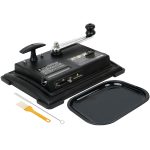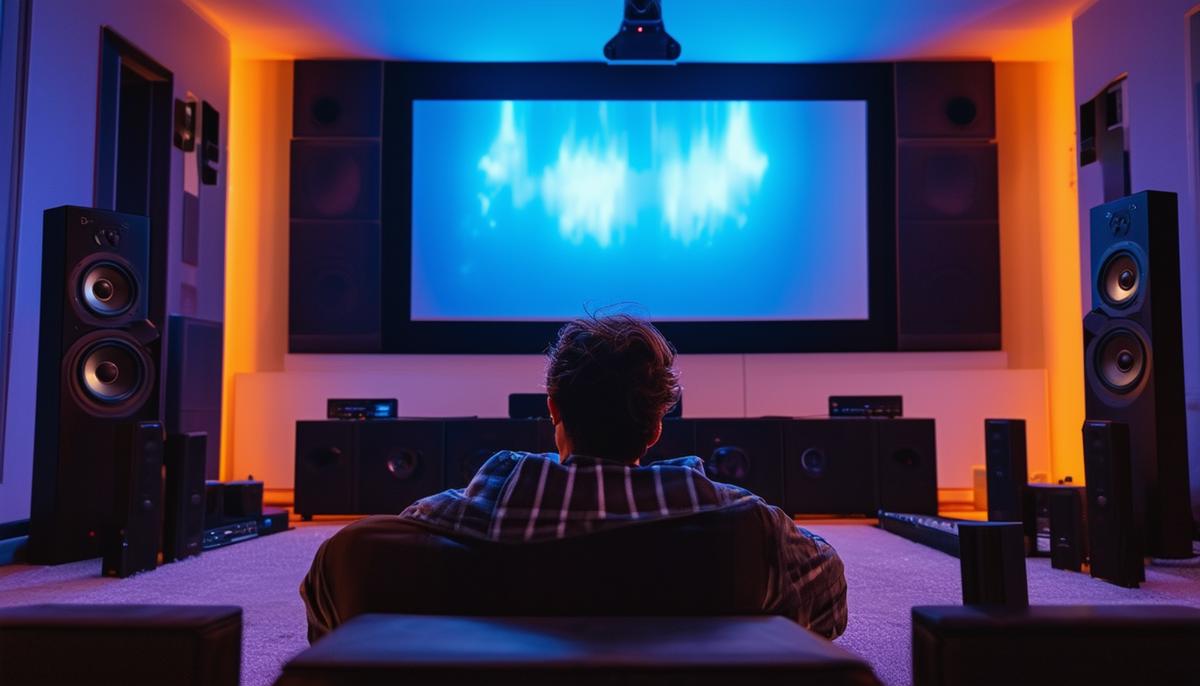Understanding Home Theater Audio Basics
Selecting the right components for your home theater system can transform your living room into a cinematic paradise. When examining the core of a home theater setup, the journey begins with understanding the various players:
- Speakers
- Subwoofers
- Receivers
- Connectivity options
Speakers set the stage for most of your audio experience. Typically, home systems vary from 5.1 to 7.1 channels. This means five or seven speakers positioned around the room, complemented by a subwoofer for deep bass. The placement of these speakers crucially affects your listening experience. Front speakers should frame the television or projector screen, while surround speakers envelop the listener, enhancing the feeling of being directly in the action.
The subwoofer handles low frequencies and adds the rumble to your movies and sports events. This component can fill a room with sounds you can feel just as much as hear, like the thunderous roll of a storm in a dramatic scene. Most setups only need one subwoofer, but audiophiles aiming to maximize their system might opt for two to balance the bass throughout the listening space.
Next comes the heart of system management: the receiver. Think of the receiver as the orchestrator, directing audio signals to the correct speakers and ensuring everything operates in sync. Receivers also handle various inputs, allowing you to connect multiple devices from Blu-ray players to streaming boxes. The potency of your experience relies heavily on selecting a receiver with enough channels to support all your speakers and one that manages various audio formats utilized by movies and games.
Connectivity finally stitches it all together, linking TVs or projectors, gaming consoles, and other media units to your receiver. With advancements in technology, wireless connectivity options like Wi-Fi and Bluetooth reduce cable clutter, although few connections might still require traditional wires for optimal audio integrity.
Understanding how each element functions within the cluster helps with crafting an ideal home theater setup perfectly suited for your space. Setup configurations can really pivot the effectiveness of your system — placement is key for optimal audio quality. Take the time to consider where each speaker will go in relation to typical seating spots; tweak and experiment with angles and distances until the sound is just right. After locking these down, dive right into enjoying movies as though you're part of every scene.

Choosing Between Soundbars and Speaker Systems
Soundbars have become a popular choice for sleek, minimalistic home entertainment setups. They offer simplicity, encompassing a range of speakers and tech within a single, elongated device that rests beneath your screen. For those in smaller spaces or who prefer a straightforward setup, soundbars are an appealing option. Besides minimal cable clutter, they offer an easy installation process.
Most newer soundbar models offer "smart" capabilities like voice control, streaming via Bluetooth or Wi-Fi, and sometimes even spatial audio effects like Dolby Atmos. However, the main drawback with soundbars is that they often simulate, rather than truly replicate, a surround sound experience. While a cascading meteor shower in a movie might sound like it's happening around you, it isn't quite as immersive as having multiple, physical speakers directing the sound waves.
On the other hand, traditional multi-speaker systems shine in the rich soundscape they create. With real speakers strategically placed around a room, each sound effect envelops you. They assert presence by generating authentic multi-directional acoustics that enhance extensive home theater setups.
However, investing in a full speaker system involves considering factors like room size, speaker placement, and the potential tangle of wires. With a wide variety of sizes, specs, and sounds available, authentic surround systems can also quickly increase in cost and setup complexity.
Ultimately, choosing between soundbars and traditional speakers comes down to a combination of practicality, audio fidelity preferences, and the layout of your space. If you want to transform a larger living area into an acoustic haven and enjoy pinpointing every sound from a specific corner, investing in a traditional speaker set may be the way to go. Alternatively, if you prefer chic minimalism or have limited space, the appeal of soundbars is clear, offering efficient functionality and elegance in one package.
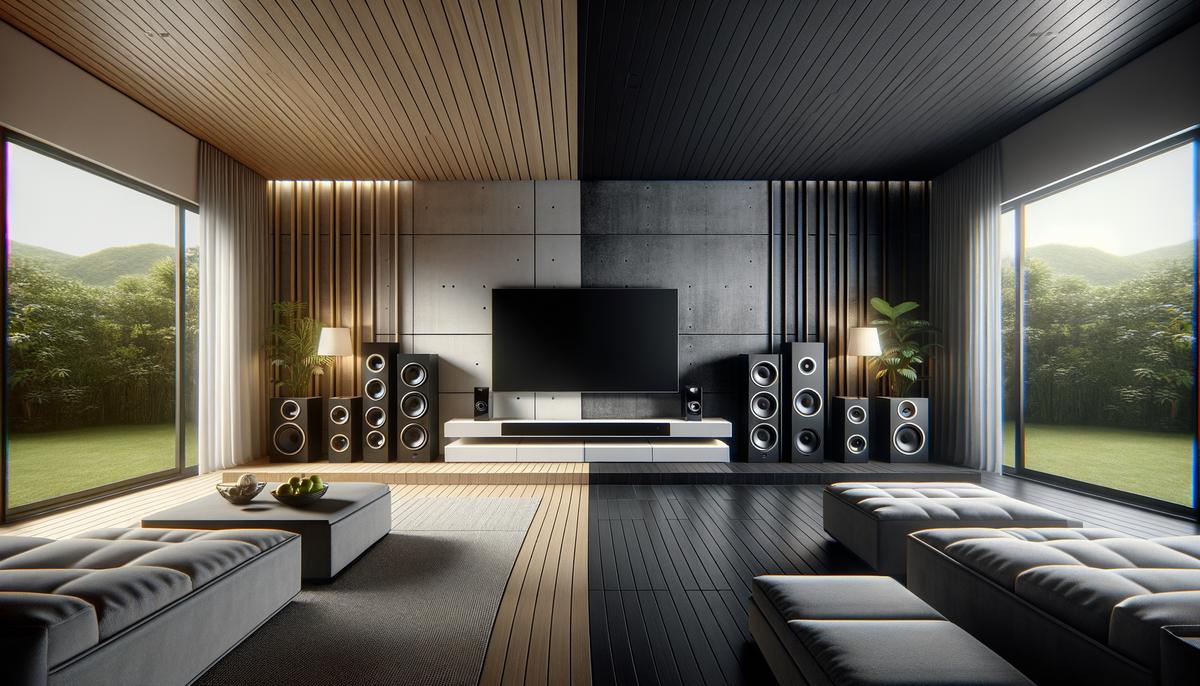
Budgeting for Home Theater Audio
When integrating the best audio setup into your home, the financial aspect is an important consideration. How much should you spend? Will a higher price guarantee better performance? Addressing this cost question requires both a realistic budget and an understanding of what each price range offers.
For beginners or those with smaller spaces, starting with a budget under $500 can still provide an enjoyable experience. In this range, you'll find soundbars and basic 5.1 channel speaker systems. The quality, though superior to standard TV speakers, might not satisfy the discerning ears of an experienced audiophile but serves as a solid entry point.
Investing in the mid-range, from $500 to $1500, introduces a noticeable improvement in quality. Soundbars and speaker systems in this category often include wireless functionality and venture into more detailed audio with higher-quality subwoofers and clearer dialogue through superior central channels. Products in this range leverage refined technology without requiring a significant lifestyle change or dedication to your new audio setup.
Moving up to the $1500 to $3000 bracket reveals elite systems packed with cutting-edge technology and impressive audio refinement. This is where authentic Dolby Atmos realistically shines, and various nuances in the audio become highly distinguishable. These systems offer personalization, precise sound distribution, and may include extras like individual app controls and sleek designs. For those who consider sound a profound journey, investments in this range mirror the content experience at a theater.
Luxury enthusiasts won't hesitate to explore systems exceeding $3000, which offer extravagant custom possibilities or top-of-the-line packages representing the pinnacle of existing options. True cinema aficionados seeking visceral experiences may find audio artistry here, where every hum and thunder roll is meticulously crafted to captivate.
"Value for money" within the realm of audio systems is somewhat subjective, largely dependent on use cases and personal expectations. Comprehensive setups can greatly enhance one's auditory experience but at higher costs, while smaller or optimized setups can achieve impressive results more efficiently for others. It comes down to balancing necessity versus nice-to-have features.
Finding the sweet spot where financial responsibility and luxurious listening intersect is key. Carefully consider your needs, conduct thorough research, take into account brand reputation, and review consumer feedback to ensure that your investment delivers the most value for your specific situation. With these insights guiding your financial decisions, you'll be well-equipped to create the home theater of your dreams.
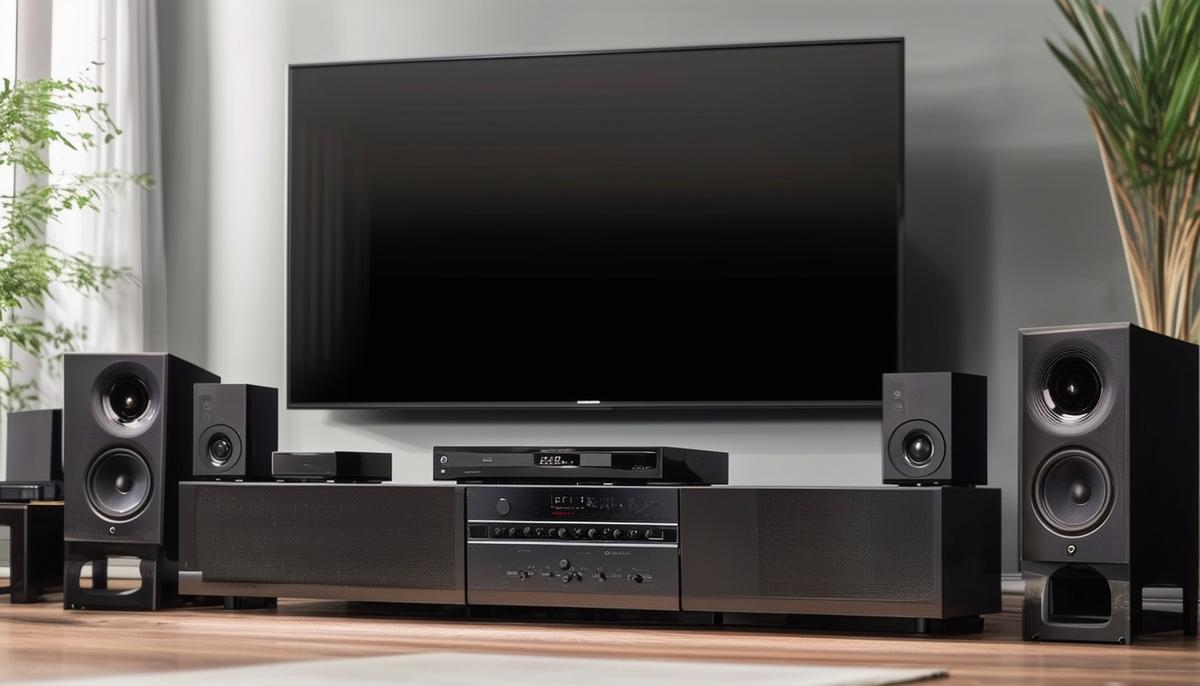
Installation and Setup Tips
Mastering the art of home theater installation involves paying attention to the finer details that can transform a mundane viewing experience into an engaging one. As we outline the specifics of installing and configuring your home theater system for optimal audio performance, remember that it's not just about having fancy gadgets, but about syncing every component harmoniously.
Speaker placement is crucial for ensuring that sound travels directly to you without loss of audio fidelity. The front speakers, which handle the majority of the dialogue and immediate sound effects, should form an equidistant triangle with your primary seating area. Intervening walls or furniture can misdirect these sounds, reducing clarity and crispness.
The center channel speaker is typically placed just below or above your screen, ensuring that dialogue is aimed precisely at your ears. Surround speakers should ideally sit slightly behind and above your main seating area at a 110 to 120-degree angle, creating an immersive dome of sound.1 This allows for realistic effects like footsteps rustling behind you or a door eerily creaking.
Given that bass frequencies are omnidirectional, you have more flexibility with subwoofer placement. However, placing it in corners can amplify its output, enveloping the room with intense low-end during action scenes. Experiment by moving the subwoofer to different points in the room to find where it best delivers that visceral impact.
Acoustics and sound tuning also play a vital role. Bare walls can reflect sound, creating echoes, while too much clutter might absorb and muffle it. Striking a good balance is key—consider investing in acoustic panels or strategically placing bookshelves to help modulate sound flow.
Connectivity is the crucial backbone of your setup. Ensure all cables and ports are neatly managed yet function efficiently. While wireless technologies can reduce wire-related headaches, remember that older setups may still require reliable, high-quality cables to fulfill the promise of high-resolution audio.
Once all components are correctly positioned, utilize the calibration tools offered by many modern receivers. These wizard-guided audio tests send distinctive tones through each speaker, mapping the sound levels to your specific room dynamics using a calibration microphone.2 This step is essential for tailoring the audio to your unique space.
By skillfully applying these tips, you become the maestro of your home theater, precisely delivering each sound into willing ears. Patience and incremental adjustments can yield a setup that not only sounds good but feels right—an immersion expertly crafted for the dedicated film lover in you.
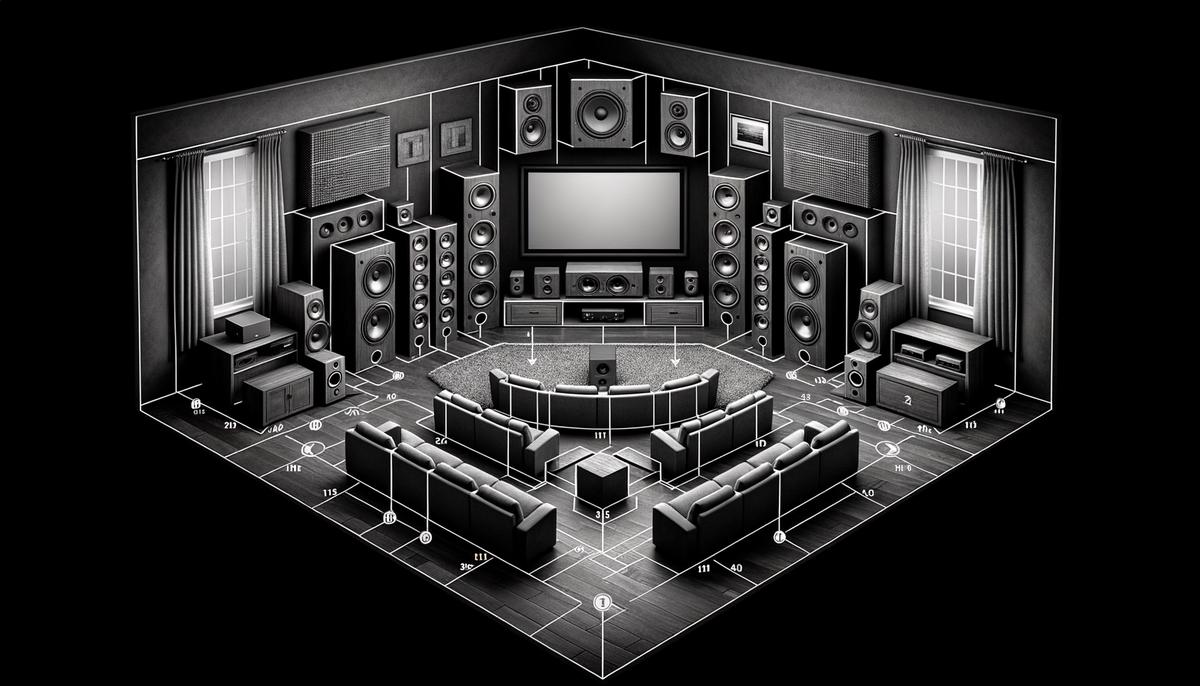
Future-Proofing Your System
A smart approach to future-proofing your home theater system involves choosing components that not only perform well today but will remain relevant as technology progresses. This forward-thinking strategy ensures that your setup stays compatible with new technologies and standards, extending the usability of your investment for years to come.
Upgradability is a key feature to consider. Look for receivers and speakers that allow for updates or expansions. Modern audio/video receivers (AVRs) often offer firmware updates that enhance capabilities and introduce new features, keeping the unit current without requiring a replacement every few years. AVRs with network connectivity can download upgrades directly from the internet, simplifying the process.
Connectivity options are also essential. As standards evolve for HDMI, optical cables, or wireless streaming protocols, ensuring your system has the latest versions, such as HDMI 2.1 which supports higher resolutions and refresh rates, is a wise safeguard against obsolescence.3 Similarly, understanding HDR compatibility, like Dolby Vision or HDR10+, can shape a future-ready theater that consistently displays the finest visuals available.
Modular systems are another smart consideration. Whether it's the ability to add more channels for an expanded surround sound or plug-in models for replacing older components, modular designs allow for customization and gradual upgrades over time. This flexibility makes it more manageable from a financial perspective and allows your setup to seamlessly align with advancements in sound technology.
In the landscape of evolving sound systems, object-based surround sound technologies such as Dolby Atmos or DTS:X are becoming increasingly important. These formats indicate a system's ability to handle 3D audio, which is likely to become the dominant standard in the future.4 Systems supporting these formats ensure you are investing in a platform that cinemas and music studios are transitioning towards.
Additionally, consider the integration of smart home ecosystems. Compatibility with systems like Google Assistant, Amazon Alexa, or Apple HomeKit offers not only voice control but also forward compatibility with other smart devices and potential updates. This positions your sound system as a central hub within your smart home universe.
The essence of a future-proof system lies in its adaptability to forthcoming advancements without compromising current functionality. Opting for cutting-edge features ensures that your home theater remains both a modern delight and a worthy investment. By making informed choices today that anticipate tomorrow's innovations, you can create a setup that will continue to deliver a captivating cinematic experience for years to come.

Creating the perfect home theater audio setup is a journey that involves not only selecting the right equipment but also understanding how these components work together to create an immersive experience. The key takeaway is the importance of speaker placement and system configuration, which are crucial for achieving optimal sound quality and ensuring that every whisper and explosion is delivered with the intended impact.
- Savov V. The ultimate surround sound guide: Different formats explained. CNET. 2020.
- Haas J. How to calibrate your TV to get the best picture. How-To Geek. 2021.
- Morrison G. HDMI 2.1: What you need to know. CNET. 2020.
- Welch C. Dolby Atmos: why it's cool, how it works and how to get it. The Verge. 2021.






